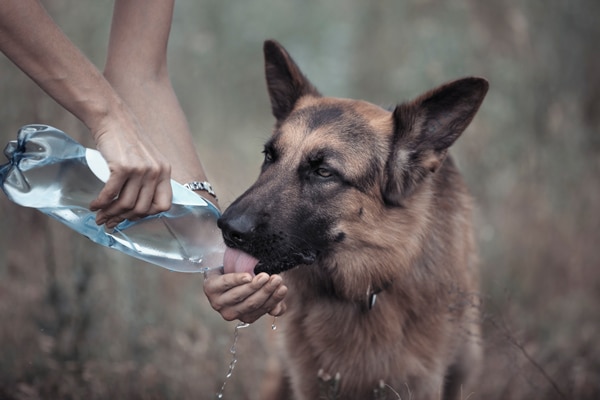Blog Signs of Cushing’s Disease in Your Dog
Cushing’s Disease, which is the increased production of cortisol is very common in dogs as they age. Cushing’s Disease is difficult to diagnose and treat, but here are a few signs to be on the look out for an early diagnosis of your dog. As always, these symptoms should be diagnosed by a licensed veterinarian. The information in this post is for information only is not meant to diagnose or treat the disease.
- Increased Thirst
An early sign is an increase in thirst. If you’re used to filling up your pets bowl once every couple days and now find yourself filling it up daily or even twice daily it’s recommended to keep a close eye on your dog to see if increase thirst appears with some of the other symptoms below. There are many reasons that your dog could be exhibiting increased thirst such as Kidney Disease and a Urinary Tract Infection(link to UTI blog).
- More Frequent Urination
With an increase in water consumption will come more frequent urination. This is where a house trained dog can all of the sudden start having accidents the house. Frequent urination can also be confused with a UTI, which is why it’s important to monitor to see if any of the other Cushing’s disease symptoms are widespread.
- Increased Appetite, Increase in Weight Gain
The increase in the hormone cortisone will cause a dog to eat more. The more a dog eats the more weight they will gain. Cortisone can cause bloating of the liver, which will give the dog a pot-bellied appearance through all the weight gain. Weight gain by itself isn’t enough to assume that your dog has Cushing’s disease. The pot-belly appearance however will as that could mean a bloated liver.
- Panting
Panting is a normal way of life for all dogs. If a dog gets too hot they will pant along with if they play and run around for a bit, same thing applies there. If your dog is panting in the a/c, after drinking more water, than it’s a great reason to take your dog to the vet to have them check for Cushing’s.
- Hair Loss
A loss of hair on your dog’s midsection could be Cushing’s disease. The hair on the head and legs will remain. It’s the midsection on both sides that needs to be monitored. Dogs should to a degree so look for the hair on the midsection to be a symmetrical loss.
- Skin That Bruises Easily
Bruises on your dog are another sign of Cushing’s. Dogs should not have bruises if they are being properly taken care of. Thin skin under the abdomen combined with bruising is another sign to make your vet aware.
- Behavioral Changes
Since Cushing’s is more likely in an older dog a change in behavior should be a very easy sign to pick up on. A dog that becomes more aggressive or more hyper than they usually are can signal the disease. Most dogs will show a change in behavior. It’s not one of the major signs to look for like the previous signs mentioned above. A change in behavior can lead to a variety of other health issues. Informing your vet is advised if your dogs behavior patterns change. If your dog has any of the symptoms listed notify your vet to setup an appointment as soon as possible. It may not mean Cushing’s disease as there are other diseases that can be confused with Cushing’s.

